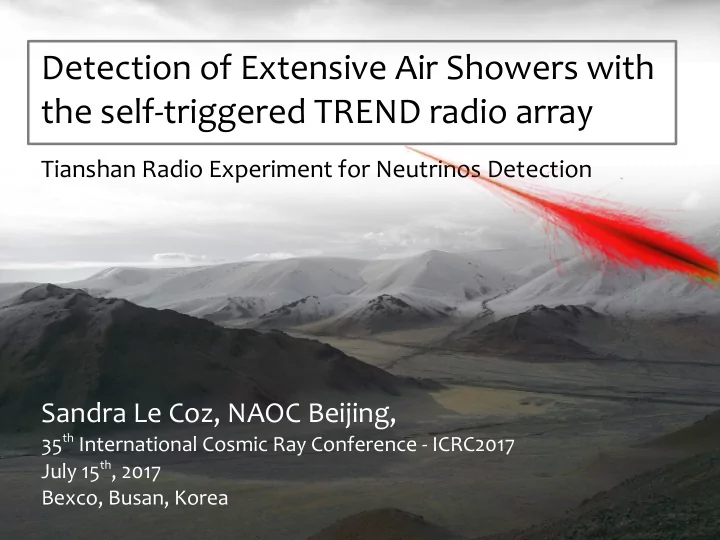

Detection of Extensive Air Showers with the self-triggered TREND radio array Tianshan Radio Experiment for Neutrinos Detection Sandra Le Coz, NAOC Beijing, 35 th International Cosmic Ray Conference - ICRC2017 July 15 th , 2017 Bexco, Busan, Korea
TREND setup Short waves Low EM noise 50 antennas Ulastai - Urumqi 50 m spacing 1.5 km² Background electromagnetic level ≡ Galactic emission ● Proposed in 2008 by : O. Martineau (Paris), V. Niess (Clermont) Wu Xiang Ping (Beijing), P. Lautridou, D. Ardouin (Nantes, France) ● Goal : establish autonomous radio detection of air showers ● Location : 21cmA radio interferometer (Ulastai, Xinjiang)
TREND setup DAQ periods : ● EW orientation 2011-2012 ~2.10 8 events recorded for EW ● NS orientation 2013 @ DAQ room: on the <2km DAQ= Data AcQuisition fly digitization optical (200MS/s+8bits) fiber 21cmA +T 0 if >6-8 s above noise pod (up to 200Hz/ant) Single polar +record if 4+antennas in antenna causal coincidence One postdoc Ex. of recorded antenna trace lost in the <300m 1024 samples field coaxial cable Ampli (64 dB) + filter (50-100MHz)
TREND data analysis Offline noise rejection cuts : Bad trace (based on EAS radio signal expectations) pulse duration, multiplicity, trigger pattern at ground, valid direction reconstruction, wavefront, direction & time correlation between events Good trace → from ~2.10 8 events to 574 EAS candidates for 316 DAQ days → background transient events ultra-dominant DAQ= Data AcQuisition EAS=Extensive Air Shower even at the radio-quiet TREND site
TREND data analysis ● The 574 EAS candidates angular distribution : overdensity of events with q >60° coming from North, as expected for EAS (radio signal if EAS ^ B geo ) → indicating candidates are likely to be real EAS B geo EAS=Extensive Air Shower ● How to check quantitatively if these candidates are EAS ? → expected angle distribution for EAS detected by TREND ? ● How many EAS were actually expected ? → efficiency of TREND to detect EAS ? DAQ= Data AcQuisition → Simulate air shower events and propagate them into TREND DAQ + offline analysis (« end-to-end » simulation)
TREND end-to-end simulation ● simulation of EAS (random core & direction) with their radio electric field using ZHAIRES ● simulation of voltage at each antenna output from each electric field using NEC2 ● insertion of simulated events in real data files randomisation of insertion time ; propagate voltages through DAQ electronic chain : frequency filter, gain, ? digitization, noise addition (from real data), trigger ● analysis of these files with standard TREND offline program → number of simulated events selected within real data computation of effective surface for each EAS q , f ,E, and aperture (m².sr) for each E
TREND gain calibration Need to calibrate TREND gain (antennas and time variations) → can be dragged from the recorded voltage <VDAQ²> , with <Vsky²> and <Vground²> expectations : kB boltzmann constant Black body Tground=290 K RL(Load)=112.5 Ohm <Vsky²> received by antenna as a function of antenna instantaneous field of view (Local Sideral Time) ● sky brightness B( q , f,n ) with LFMap ● antenna effective area Aeff( q ', f ' ,n ) computation with NEC2 → Computation of gain Gtot from noise level monitoring,each 20 min
TREND gain calibration For purpose of illustration only : Gain unique value adjusted to fit mean recorded voltage on 1 day for 1 ant. Only a scale of Gtot is necessary to get a peak to peak match → & | model - data | < 10% validation of model BUT : other measurements indicate additional noise of 0% to 20% → Gain possible bias of 20% → Gain uncertainty = [Gtot/1.2 , Gtot] Local Sideral Time [h]
TREND end-to-end simulation Data subset : ● Period 6 of DAQ ● Runs 3562 to 3733 ● Feb. 23 th to June 19 th 2012 ● 80 DAQ days ● Nselected real events = 205 DAQ= Data AcQuisition EAS=Extensive Air Shower Simulation set : ● proton EAS ● [5e16, 8e16, 1e17, 2e17, 3e17, 5e17, 7e17, 1e18, 3e18] eV (up to 10 K simulated EAS per energy) ● Nselected simulated events leads to effective surface :
TREND aperture Aperture of TREND : real TREND antenna & DAQ state + offline analysis « ideal » offline analysis (do not cut air showers) « ideal » TREND antenna & DAQ (100% of time working) Statistic uncertainties at +-1 s For gain = Gtot Erf fit
TREND expected events Expected number of events in D t = 80 DAQ days : F(E) = cosmic ray flux [/GeV/m²/sr/s] = [159, 240] for real TREND antenna & DAQ state + offline analysis = [370, 561] for « ideal » offline analysis (do not cut air showers) = [2188, 3279] for « ideal » TREND antenna & DAQ (100% of time working) (uncertainty comes from gain calibration bias of 0% to 20% ) Effective number of events in the subdata set = 205 → satisfying modelisation of EAS radio emission + TREND response
TREND expected events Angles distributions for selected events : - - - Gtot/1.2 __ Gtot ● Partial agreement between data and simulation distributions shows that TREND has indeed detected air shower events ● Excess in data indicates noise contamination of ~30% for Gtot/1.2 case
TREND efficiency 2188 to 3279 17% 7% 370 to 561 43% 159 to 240
Conclusion and 'to do' Conclusion ● TREND system well understood ● Autonomous radio detection EAS goal reached first time ever ● Detector efficiency 17% and EAS selection efficiency 43% ● Noise contamination ~30% ● Promising for future neutrinos experiments such as GRAND (see [NU039] & [CRI187], this conference) To do ● Compute efficiencies also with iron EAS & for the whole DAQ period ● Submit a publication on the results
Recommend
More recommend